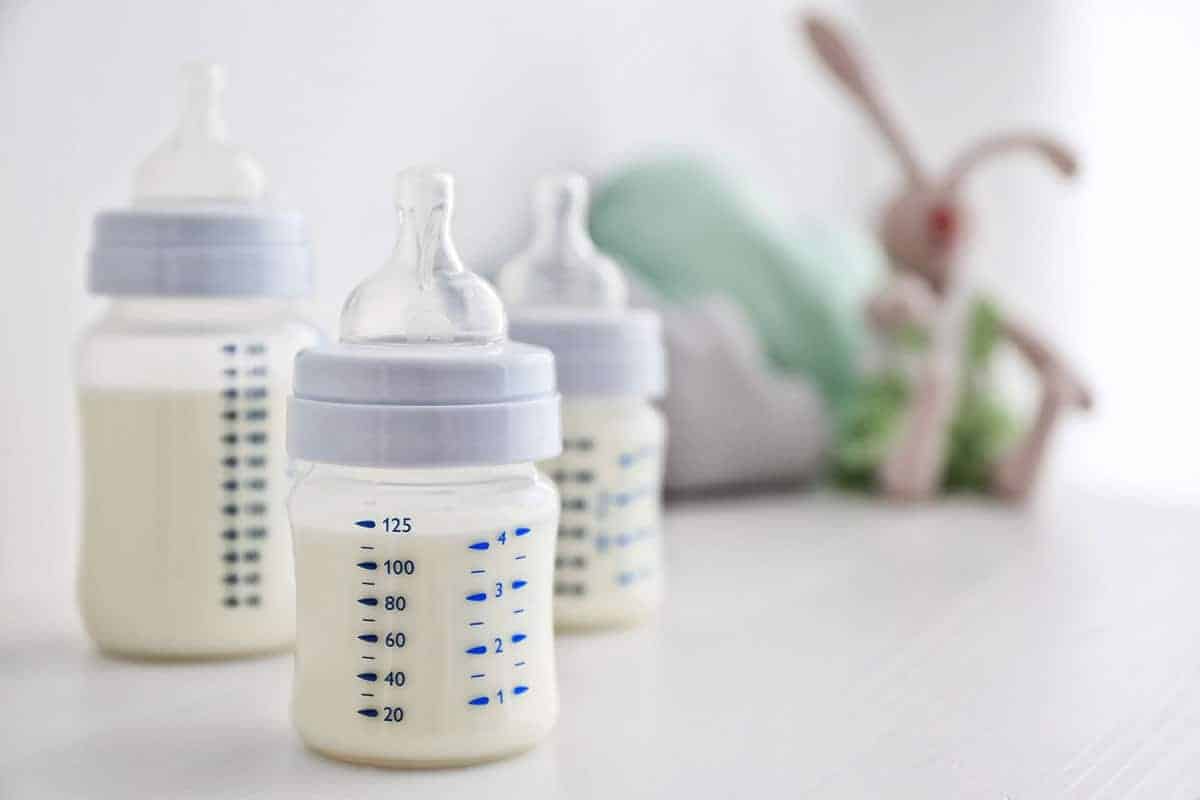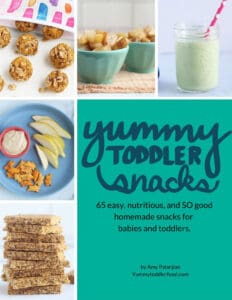Stopping night feedings can be an important milestone for your baby or toddler—and mean better shut-eye for them and you. We’ve got all the info you need to consider when night weaning, plus strategies on how to do it successfully with minimal tears.

Night Weaning
When your baby is a newborn, you’re used to them waking up several times a night to nurse or take a bottle. But, as they grow, their nutritional needs change and it’s OK to cut back and/or eliminate feeds throughout the night to help everyone get more sleep. (Always the goal!)
However, by this point, many babies are used to waking up several times a night for nighttime feedings, so getting them to a place where they’ll go at least 7 hours without one can be a bit of a process. The good news? Alicia Birdsong, a certified pediatric sleep consultant and founder of Hush Little Birdie Pediatric Sleep Consulting is here to walk you through how to do it.
TIP: We’re going to share tips on night weaning both babies and toddlers, from formula and breastfeeding since there’s no one right age to do this.
Your toddler won’t eat? Help is here!
Sign up for our email updates to get tips and ideas sent to your inbox.
When to Wean
“So first thing when it comes to night weaning, I think it’s important to talk about when it’s nutritionally appropriate to night wean,” Birdsong says. This is something you should talk to your pediatrician about, but typically babies between the ages of 6 and 8 months are ready to go through the night without eating.
“It’s sometimes a little younger, or a little older,” adds Birdsong, “but this seems to be the average age to night wean.” One of the biggest indicators you can look for is a child doubling his or her birth weight, which tends to correlate with not needing to eat at night. Other clues that it might be time to wean are if your baby is having trouble getting back to sleep after feeds or is waking at other times of night when it’s not time to eat.
Learn to Promote Independent Sleep
The thing with night weaning is that it’s often not just about eating; it’s about the fact that your baby is used to either nursing or having a bottle to fall asleep and get himself back to sleep throughout the night. If you’re not ready to teach your child to fall asleep on their own or do full-on sleep training, Birdsong explains, you can switch eating with another sleep association like rocking to sleep or cuddling.
However, “if you’re ready to help them fall asleep independently without any assistance from you, that is likely going to result in better quality sleep,” Birdsong says. “If you help them learn how to fall asleep independently, then it sets the stage for them to be able to connect their sleep cycles and stay asleep longer.”
There are many methods for helping kids fall asleep on their own—you can check out Birdsong’s Instagram for more advice—but the part that is related to weaning is really making sure your child is not dozing off while eating. This might mean moving nursing or the bottle feeding to the beginning of the bedtime routine—with the lights on!—and then doing a book or a song or something after that before putting your child in the crib.
If you nurse or have a breastfed baby, you might even want to have your partner take over that second half of bedtime so your child is not expecting you to feed him to sleep.
How to Cut Back on Feedings
It’s important that you get the bedtime routine on track, because however your child is falling asleep at bedtime will also be how they’re expecting to get back to sleep during the night. Once you’ve established that your child is ready to night wean, you may choose to go cold turkey and remove the feeds altogether.
“If you would like to do something more gradual, though, you can still offer a night feed but slowly adjust how long the feed lasts,” Birdsong says. For example, if you typically nurse for 6 minutes, you can cut that down by a minute every few days until the feedings taper off. (Same works for bottle feeding—just cut down the amount of formula you offer.)
To align with your child’s independent sleep routine, once you remove that night feeding anytime they wake up, you should handle it with whatever method you’ve decided to use at the start of bedtime.
“The more consistent you are, the easier it’s going to be for them to learn a different way of doing things,” Birdsong says.
A Note on Co-Sleeping
Co-sleeping can pose extra challenges when night weaning. “It may be really hard if you’re right there, and your baby is used to nursing and you’re telling him or her no…especially in the middle of the night when they’re tired,” Birdsong explains. The solution? You might need to head to the guest room for a few evenings and let your child and your partner sleep together without you.
“If you’re not physically not present for, let’s say the first 4 to 5 nights, then the thought of nursing won’t be nearly as prevalent and your partner can offer other forms of comfort,” Birdsong says. Depending on your child’s age, this could include snuggles, a stuffed animal, or a pacifier.
It depends. Once your child is ready to drop their night feeds, you can choose to go cold turkey and stop nursing or giving bottles during sleeping hours altogether. (If you’re nursing, though, you may need to wake up to pump for a few days while your body adjusts to the milk supply and demands.) However, many parents choose to cut down the number of feeds and amount of milk or formula offered gradually, which can take a few weeks.
Nutritionally speaking, most babies can do without night feedings between 6 and 8 months of age or once they’ve doubled their birth weight. But it’s important to ask your pediatrician for the go-ahead before eliminating these nursing sessions or bottles.
You’ll need to get your baby out of the habit of falling asleep while breastfeeding, and this may mean adjusting your bedtime routine. One easy way to do this is to simply move nursing to the beginning of the routine. This may mean nursing first, with the lights on, and then getting them into their sleep sack and reading a book or singing a song after that, for example. Another trick: Have your partner take over the rest of bedtime after nursing, to help further separate the act of nursing from falling asleep.
How to Night Wean a Toddler
Once kids are over 12 months, it can be harder to wean them at night simply because they’ve been in the habit of waking for a longer period of time. It can be frustrating to cut down on feeds slowly for this age, as I found when I night weaned my third kiddo at 14 months. The same advice as above applies, though the kids may have more feelings about it.
After three nights of trying to gradually reduce the duration of our feeds, I knew it was not working. My letdown would barely be over and the timer was up and the baby was confused about why I was only giving him a little milk.” I worked with Birdsong to develop a plan to cut the night feedings cold turkey, and after two nights, he was sleeping through the night. Yes, that may mean crying temporarily, but I found that the clear rules were much easier for everyone to understand.
The goal of night weaning—once the child is nutritionally able to go through the night without breastmilk or formula—is to break the habit of waking up during the night and get onto a more consistent sleep schedule for both the child and the parent. That can take 2 nights or a week, and it may have the benefit of the kids being hungrier for milk or solid food during the day. It’s a process, so be gentle with yourself through the transition.
Best Tips for Night Weaning
- Wait until the child is nutritionally ready to night wean. This typically happens when babies are between the ages of 6 and 8 months.
- Work on disassociating sleep and eating by giving the last feeding of the day with the lights on and adding a book or a song after the feeding. The goal is to put baby down awake so when they wake up during the night, they will be able to go back to sleep without a feeding.
- Go gradual by shortening the duration of feeds by a minute (or decrease ounces of formula) each night until you get down to zero, and offer alternative comfort during wake-ups, like snuggles or a pacifier.
- Or, go cold turkey by deciding on a day when night feedings will end and say goodnight to the little and leave them be until morning.
- Remember that you may need to pump a small amount for a few nights to help your body adjust (but don’t pump too much or you will tell your body that it needs to be producing milk at that time—aim for just enough to give you relief).
- A toddler who feeds during the night may have a decreased hunger for daytime milk and solids, so cutting out the night feeds can help move that intake to the daytime. (A bedtime snack may help ensure toddlers have enough in their tank to sleep well at night without a feeding.)
- If you co-sleep and have been in the habit of nursing to sleep and back to sleep, it may help to sleep in another room for a few nights as you transition.
- Whatever approach you take, be consistent. Discuss any concerns you have with your pediatrician.
- Find more resources on Sippy Cups, Toddler Formula, Weaning in General, and Homemade Baby Food.
Related Posts
Find our full guide to Weaning Toddlers here. And reach out to Birdsong for additional personalized support. Get $20 off a package with the code yummytoddlerfood.
This post was first published April 2021.






















